
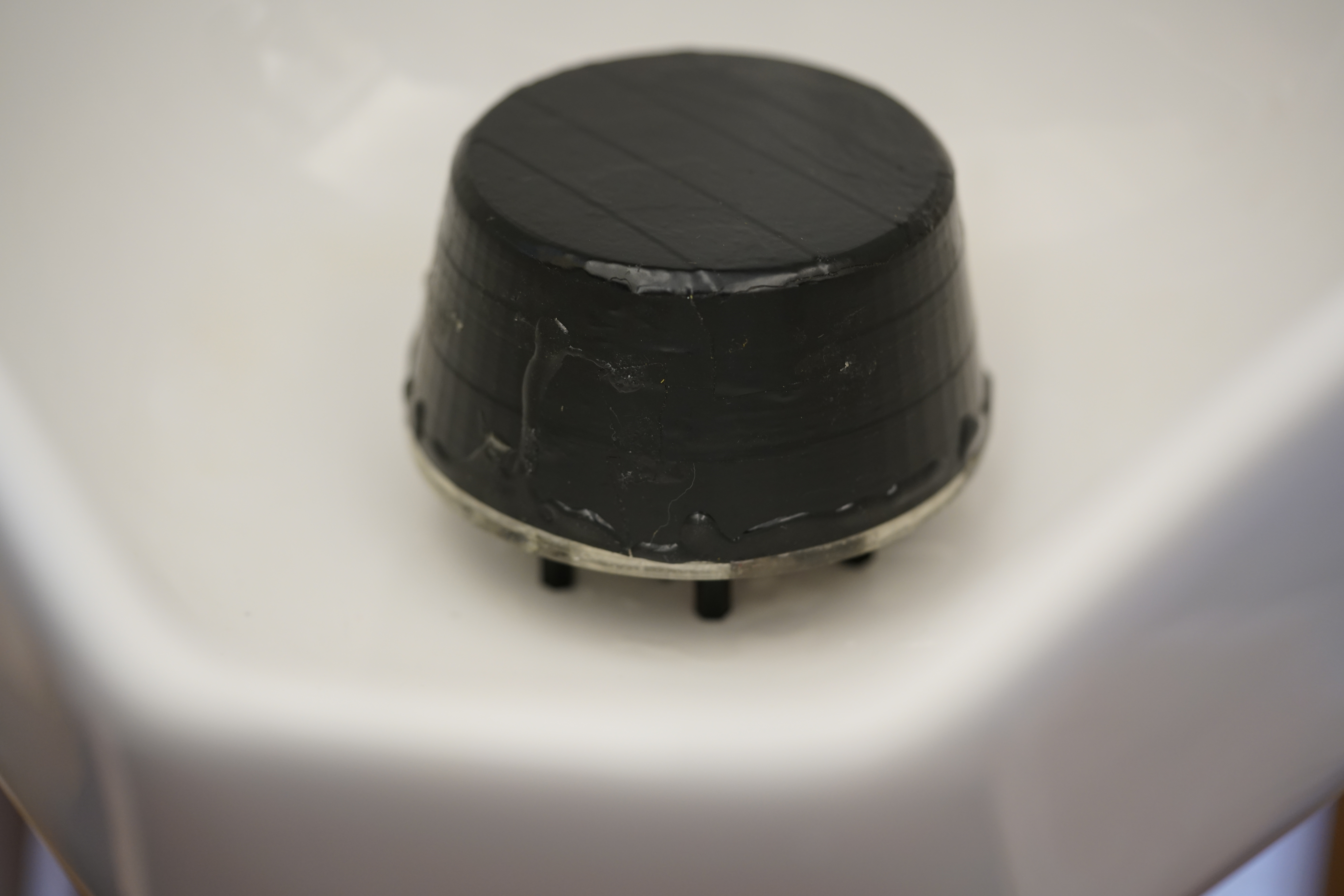
Concept
Tinkl is a health monitoring system spread out across the city that uses information from lavatory usage to allow individuals to keep tabs on their health on the go, and to allow the city to be apprised of the collective health of the city’s population.
Our device integrates color, temperature, and turbidity sensors into an unobtrusive package that can operate in the messy environment of a urinal, sensing key properties of urine and transmitting an analysis of the data to individuals on demand, as well as to city authorities for centralized monitoring of a city’s collective health.
Motivation
Currently, individuals do not have easy access to basic measures of their health such as temperature on the go; at the present moment, cities do not also have an effective means to track with frequency, the collective health of the city’s population.
Our project aims to remedy this, by creating a small and cost-effective package that can be unobtrusively distributed around a city’s many lavatories, and which can sense a person’s health markers from a trip to the lavatory, making it easy for a person to keep tabs on his health anywhere and anytime, and allowing for the city’s collective health to be monitored in real time.
Requirements
Functional
- Urinal puck is capable of collecting urine and analyzing its color, clarity and temperature
- Collection mechanism capable of preventing cross-contamination of urine samples across different individuals
- System is capable of predicting basic health markers like hydration level and basal body temperature from collected data
- System provides means for individuals to log when they are using a urinal and access health data on demand via a smartphone app
Nonfunctional
- Urinal puck should be small and waterproofed (up to IP65 rating)
- Urinal puck should be unobtrusive, preventing user discomfort
- Urinal puck should last ~2 weeks - 1 month on a battery
Use Cases
Our systems are designed to allow people to increase awareness of their health, by enhancing the accessibility of key health markers available in urine. We envision several possible use cases for this system: Similar to Hydralert’s concept, our system can enhance workplace safety. In industries necessitating outdoor activity, this can allow workers to be aware of markers such as their body temperature and hydration levels, and adjust their water intake accordingly to ensure that they do not suffer the adverse effects of heat stroke or other heat and hydration-related ailments. Employers will be able to monitor their employees overall hydration and health markers, and respond accordingly to encourage better employee health and safety while on the job. Our system also provides a means for individuals to be more cognizant of their health. In urban areas where our system is ubiquitous, an individual’s health information can be easily analyzed, and will be collated and made available in an easily understandable format at the touch of a button.
Competitive Analysis
UnderworldsMIT’s Senseable City Lab
Research project by MIT’s Senseable City Lab analyzing wastewater and sewage for biomarkers of human health, with the goal of massively collecting data and using ananalytics to allow the health of the city to be monitored, from the scale of a neighborhood to the aggregate health of the entire city.
While this project aims to enable city-wide health monitoring through large-scale, city-wide data collection and analytics just like the Underworlds project, we also aim to provide individuals with the ability to have their health assessed on demand, by providing an interface through which they can log their lavatory usage and access their collected health data.
Toto Intelligence Toilet
A smart toilet designed by Japanese toilet-maker Toto, that features a “sample catcher” capable of obtaining urine samples, and which can track your urine temperature, analyze glucose levels and transmit the information to your computer over WiFi, for closer inspection by yourself or a trained physician.
This project is targeted at high-end personal health analytics (it features expensive analysis techniques such as glucose analysis and limited communication); in contrast, we aim to create a low-cost highly networked array of smart urine analyzers that can be used by individuals over a broad swath of geographic locations at any point in time, and which can allow for aggregate health of large areas to be tracked.
Hospital in a Toilet - Hackaday project
Project to create a compact device that can be embedded in an individual’s toilet and which can perform basic urinalysis (particularly analyzing color and specific gravity of urine) to ease monitoring of both general health as well as chronic medical conditions.
Our project essentially scales the “Hospital in a Toilet” idea up, aiming to create a cost-effective distributed network of such “hospitals” across the city to allow individuals the convenience of checking on their health at any geographical location at any time, while also facilitating city-wide health monitoring.
Tech Specs
Urinal Puck
- RGB light sensor breakout board ISL29125 - Sparkfun, $7.95
- NTC thermistor - Digikey, $2.26
- Analog turbidity sensor SEN0189 - DFRobot, $9.90
- nRF24L01+ Enhanced Wireless Module - GearBest, $0.99
- ATMega328P microcontroller - Mouser, $2.26
- MCP1700 low quiescent current regulator - Mouser, $0.40
- 1.5V Alkaline AA batteries (3x per puck) - Amazon,
- $2.30 Custom-designed PCB combining sensing, comms and MCU
- Custom-designed, 3D-printed plastic and lasercut acrylic puck
- Efficient custom data transfer protocol

Hub
- Raspberry Pi 3 Model B (ARMv8, 1GB RAM) - Adafruit, $39.95
- nRF24L01+ Enhanced Wireless Module - GearBest, $0.99
- Custom Protocol Buffer (protobuf) to upload data to server
Server
- Python and Tornado server to listen to hub data
- Protobuf to decode data stream from hub
- Google Remote Procedure Call (gRPC) server for Android app
Smartphone App
- Android Operating System
- Google Remote Procedure Call (gRPC) client to fetch urination data from server
- Protobuf to decode data stream from server
- Google Play Computer Vision library for QR code detection
- MPAndroidChart for data visualization
Demonstration Urinal
- Sponsored Urinal
- 2x4 Lumber for frame
- Copper tubing
- 2x 5 gallon drums for water storage
- Water pump to pressurize system
- QR Code to identify puck and hub
Architecture
Based on our design requirements, our lavatory health monitoring system has two primary users and end-goals in mind: to help individuals gain easy access to health monitoring city-wide, and to enable monitoring of the city’s collective health through distributed urinalysis. System-wide, our architecture will adopt a hub-and-spoke model, with multiple sensing nodes in each bathroom (urinal pucks) connecting to a local bathroom-level server/gateway which performs analysis and interacts with individuals requesting personal health data, and which also funnels data to a central city server.
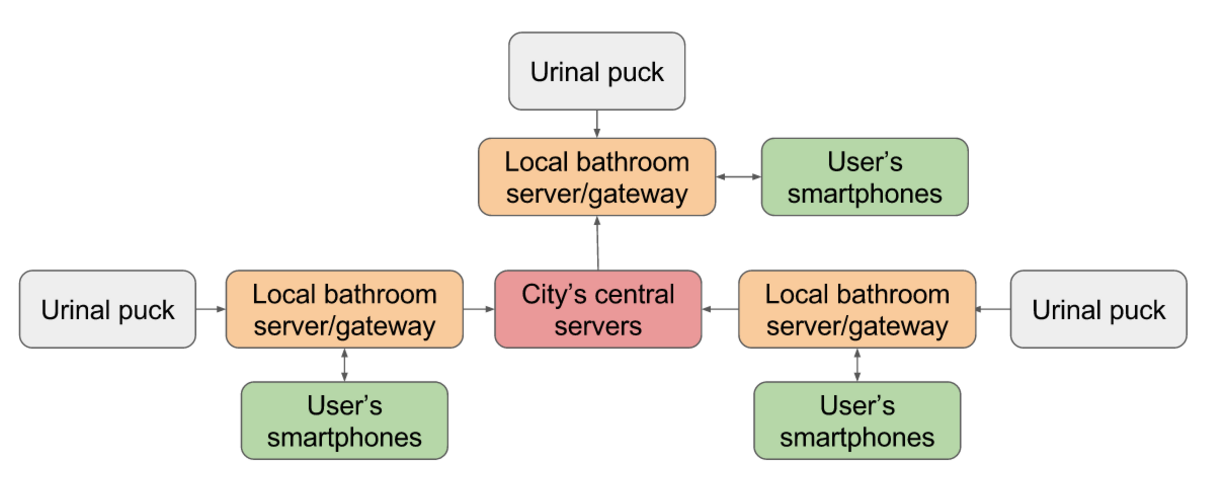
In order to gather data, the user will urinate into the urinal. The puck will collect this urine passively and will be woken up by the presence of urine. Once woken up, it will begin sensing and data collection and stream its results to the hub located in the bathroom. The hub will aggregate data from multiple pucks and periodically send it to the city-wide server for further processing. A user can also connect to the local hub to gather basic analytics and data after indicating their desire to receive such data.
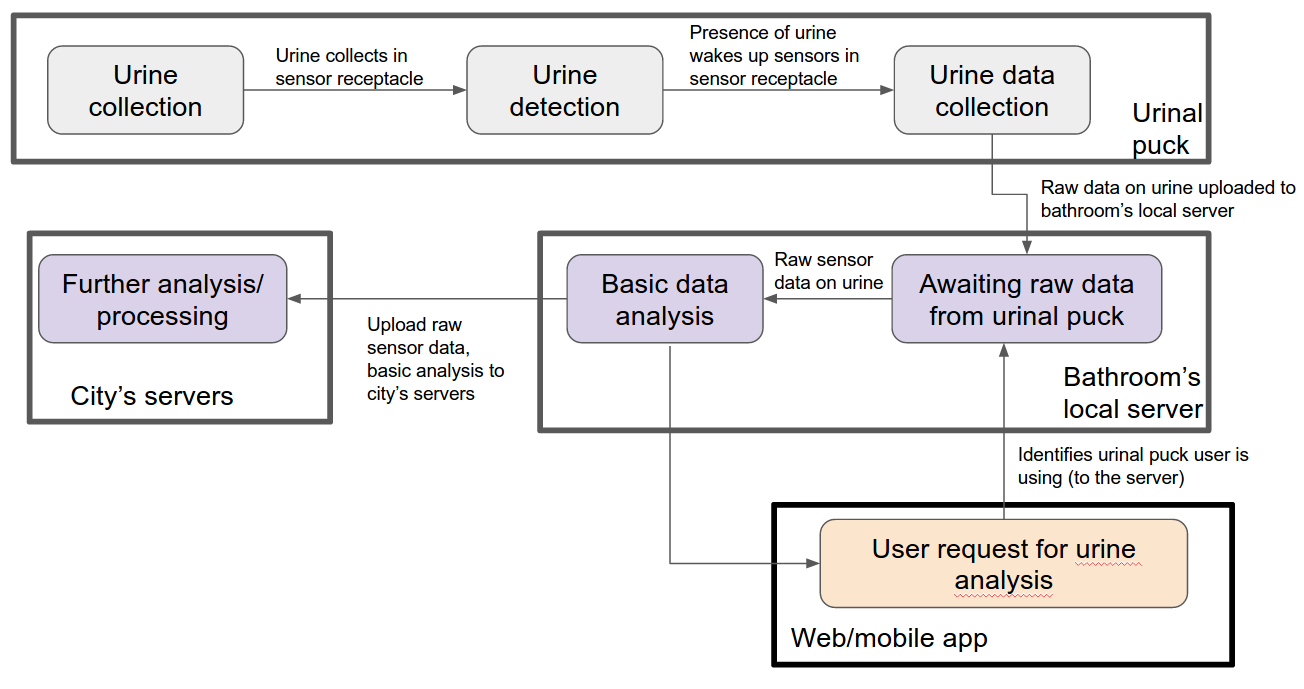
System Interaction
Our system uses a number of different technologies to facilitate all of the communication between different components. Below we’ve detailed the methods by which each component will talk to each other component. For simplicity, only one puck and hub are drawn, though the communication technologies between the pucks and hub, as well as those between hubs and central server, trivially scale to multiple connected devices. In short, the puck communicates with all of its various sensors through either an I2C ADC or directly over I2C. The puck transmits its data to the hub over an I2C radio, which then forwards the information to the server via WiFi.

Final Product
After a semester’s work, we produced a puck capable of measuring turbidity, temperature, and color from urine samples. The puck has a watertight enclosure to protect from the harsh conditions to which it is exposed. It uses an algorithm optimized for low power usage in order to obtain the projected battery life of approximately 1 year. The samples gathered by the puck are aggregated into a urination event, which is then sent to the hub inside the bathroom. The hub forwards data to the server. This data can be accessed from the user’s smartphone when they scan the QR code next to the urinal; the Android application will then request the data for the most recent urination event for that urinal from the server. The server will respond with the data if it is less than 5 minutes old, as a security measure. After this process, another person may use the urinal, and the cycle will begin again.
For more detail on the development process, as well as specific numbers and charts, please see our final report (linked below).
Sensing Algorithm
while True:
temp = read_from_thermistor()
if temp > threshold: // Take detailed sensor readings
samples = []
for sample_number = 1 ... 30:
samples[i] = take_sample()
short_sleep()
send_data_to_hub()
else: // There's no urine, wait for some time.
long_sleep()
Puck Design
The puck design consists of a 3d printed enclosure, sealed with epoxy, surrounding a custom PCB which houses the sensors, radio, and MCU. Inside, above the PCB is a space for the batteries, as well as the breakout board for the turbidity sensor. The individual components are labeled below, as well as a fun picture of the bottom of the puck.
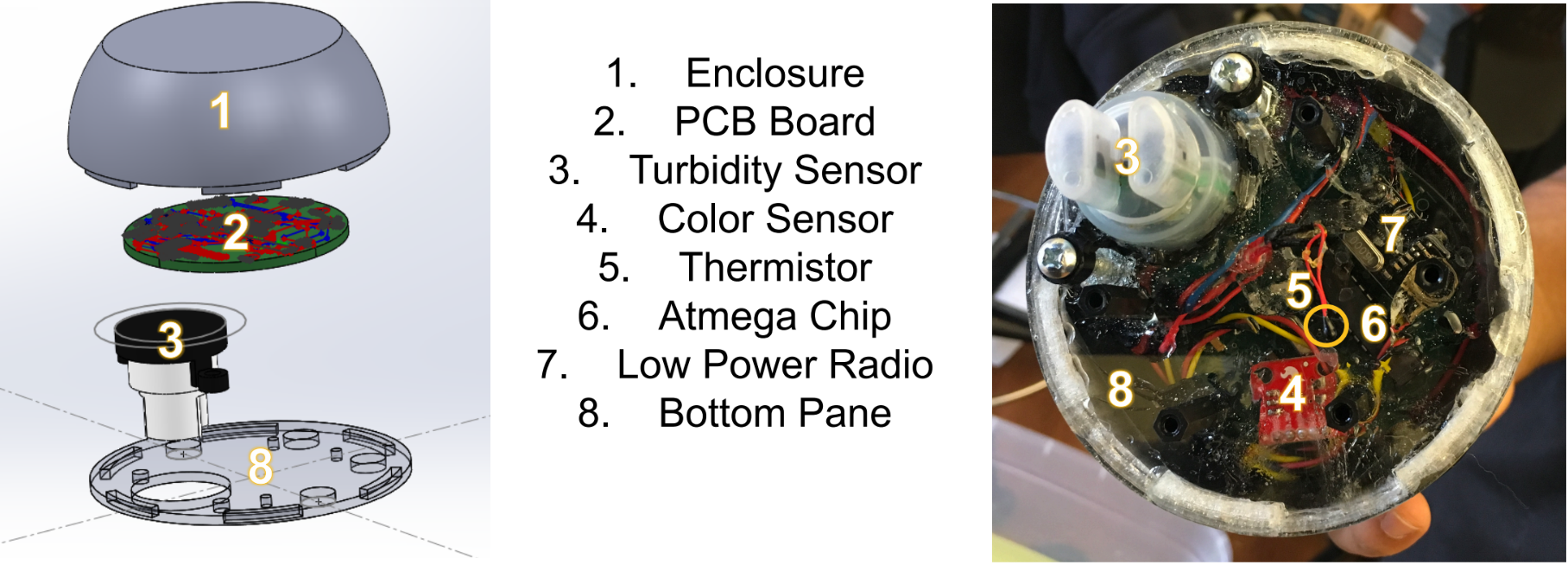
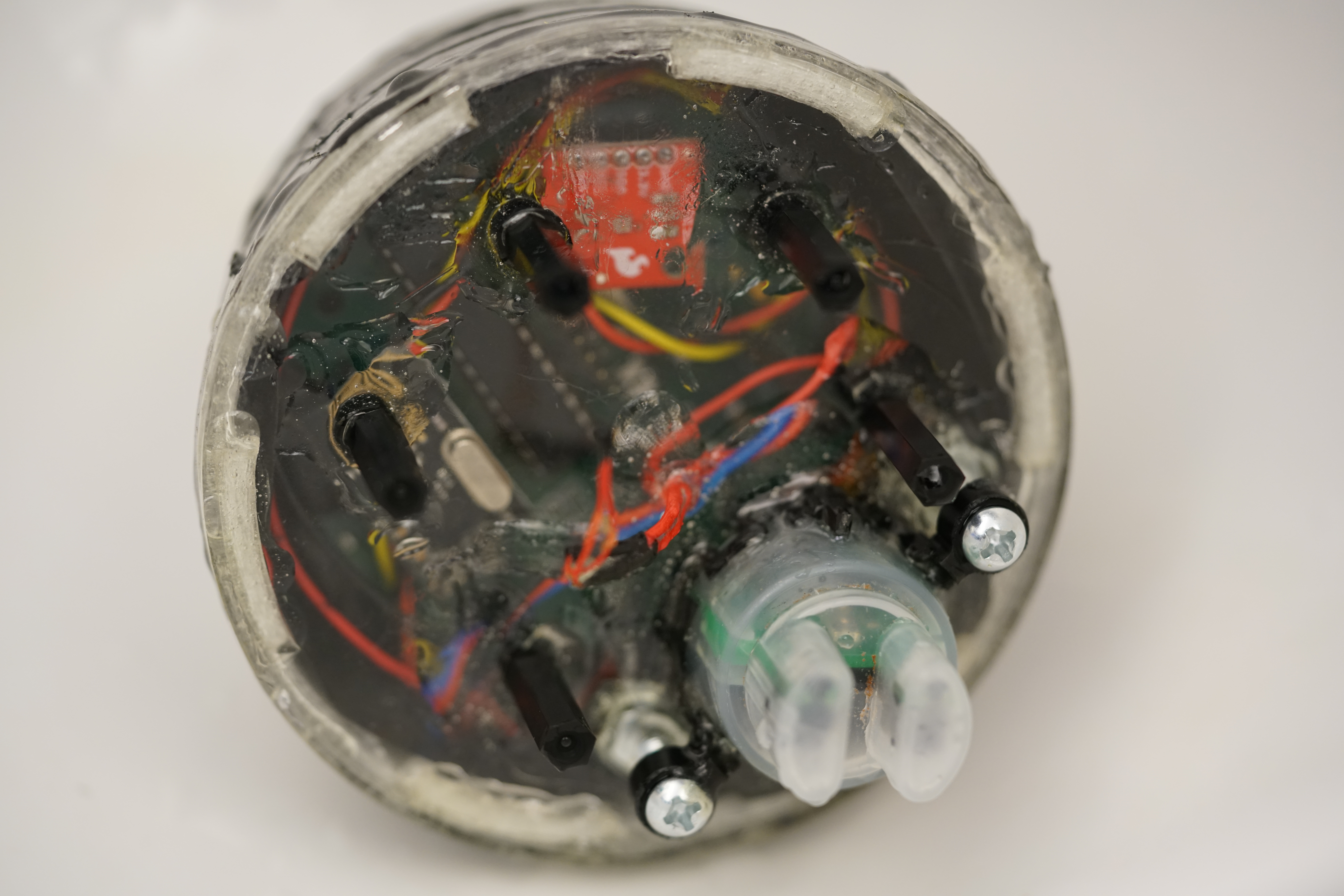
Overall Changes
Our original plan was to design a system to be useful at both a personal and institutional setting. However, privacy concerns arose over the course of the semester which suggested that we target only a personal use case, so we adapted our model to focus primarily on individual users. It is for this reason that data is inaccessible on the server after 5 minutes. Switching the system to allow an institutional viewer to look at the data would not be technically complex, but would require exploring privacy problems which proved to be beyond the scope of our project.
For the majority of the semester, the puck design revolved around restricting the urine stream through the drain, allowing it to pool up, and then analyzing the pooled liquid as it slowly drained. Shortly before the demo, however, we realized that this design prevented multiple uses of the urinal in quick succession; each flush would take upwards of 5 minutes to drain, which is not acceptable for an industrial setting. Instead, we decided to remove the flow restrictor and elevate the puck above the surface of the water. We then oriented the turbidity sensor such that it was always below the resting water line of the urinal, and found this to be a much better design overall for both portablity and usefulness; the puck could now be transferred to almost any similar urinal, and did not limit flushes at all.
Apart from these minor changes, we are happy to say that the rest of the system was implemented exactly as designed. Our architecture and communication protocols at every level proved sufficient and robust enough for our application, indicative of the thought and care we put into the designs beforehand.
Future Work
A conference call with one of our sponsors, Kohler, revelead a number of areas for possible future work. One in particular stands out as potentially game-changing for urinals. Today’s automated flush mechanisms rely on cheap IR distance sensors which are often inaccurate and error prone. Many flushes happen prematurely, or can simply be triggered by a passerby. IR sensors may also become blocked a result of smoking or chewing gum usage. Such an error prone system necessitates the inclusion of a manual flush valve. Due to the direct contact thermistor in our system, we detect the presence of urine much more accurately than existing systems. It is possible to integrate this detection into the flush mechanism as a trigger. The high precision would all but remove the need for a flush valve, permiting the cost savings to be passed into the development of the puck. Clearly, there is enormous potential here simply waiting to be explored.
Team Members
Acknowledgements
- Anthony Rowe, our professor, for being as excited about our project as we were
- Craig Hesling, our TA, for guiding us through this journey
- Kohler, for the donation of a urinal and flush valve, as well as the advice and guidance of their engineers
- Sloan, for the donation of our first urinal and flush valve, used in our final demonstration.
- American Standard, for the donation of a urinal and flush valve.